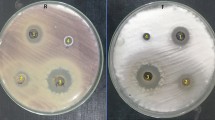Abstract
The main objective of this study was to evaluate the effectiveness of crude chloroform extract of Piper betle L. (PbC) in controlling Fusarium wilt of tomato (Lycopersicon esculentum) caused by Fusarium oxysporum f. sp. lycopersici. It was observed that 1% (w/w) amendment of the PbC in soil was more efficient in reducing the Fusarium population in soil than carbendazim and the combined amendment of carbendazim and PbC. Fusarium wilt control studies were carried out in a greenhouse. Variation in different parameters like shoot growth, root growth and mean fresh weights of tomato seedlings in all the treatments were recorded. Accumulation of total phenolics was also studied from the root tissues of tomato. Higher accumulation of total phenolics was observed in the Fusarium-infested plants as compared to that of healthy control and PbC-treated plants. Moreover, it was observed that the extract could reduce the symptoms and disease development. Electron microscopy studies were also done to observe the Fusarium infestation in the vascular bundles and to show the accumulation of total phenolics in the vacuoles of root tissue.





Similar content being viewed by others
References
Agrios GN (2005) Plant pathology. Elsevier Academic Press, NewYork
Alabouvette C (1999) Fusarium wilt suppressive soils: an example of disease suppressive soils. Australas Plant Pathol 28:47–64
Aneja KR (2005) Experiments in microbiology, plant pathology and biotechnology. New Age International (P) Ltd, New Delhi
Benner JP (1993) Pesticidal compounds from higher plants. Pest Sci 39:95–102
Bennet RN, Wallsgrove RM (1994) Secondary metabolites in plant defence mechanisms. New Phytol 127:617–633
Booth C (1971) The genus Fusarium. Commonwealth Mycological Institute, Kew
Bowers JH, Locke JC (2000) Effect of botanical extracts on the population density of Fusarium oxysporum in soil and control of Fusarium wilt in the greenhouse. Plant Dis 84:300–305
De Vecchi L, Matta A (1989) An ultrastructural and cytochemical study of peroxidase, polyphenoloxidases and phenols in xylem of tomato plant infected with Fusarium oxysporum f. sp. lycopersici or Fusarium oxysporum f. sp. melonis. Caryologia 42:103–114
DeVay JE, Garber RH, Wakeman RJ (1988) Field management of cotton seedling diseases in California using chemical and biological seed treatments. In: Proceedings of Beltwiae cotton conference, National Cotton Council of Americana, Memphis, TN, USA, pp 29–35
Diehl T, Fehrmann H (1999) Wheat fusarioses: Influence of infection date, tissue injury and aphids on leaf and ear attack. J Plant Dis Prot 96:393–407
Garibaldi A, Guglielmone L, Gullino ML (1990) Rhizosphere competence of antagonistic Fusaria isolated from suppressive soils. Symbiosis 9:401–404
Lewis NG, Yamamoto E (1990) Lignin: occurrence, biogenesis and biodegradation. Annu Rev Plant Physiol Plant Mol Biol 41:455–496
Liggit J, Jenkinson P, Parry DW (1997) The role of saprophytic microflora in the development of Fusarium ear blight of winter wheat caused by Fusarium culmorum. Crop Prot 16:679–685
Lumsden RD, Locke JC (1989) Biological control of damping-off caused by Pythium ultimum and Rhizoctonia solani with Gliocladium virens in soilless mix. Phytopathology 79:361–366
Matta A, Ferraris L, Abbattista GI (1988) Variation of phenoloxidase activities and the consequence of stress induced resistance to Fusarium wilt of tomato. J Phytopathol 122:45–53
Minerdi D, Bossi S, Gullino ML, Garibaldi A (2009) Volatile organic compounds: a potential direct long-distance mechanism for antagonistic action of Fusarium oxysporum strain MSA 35. Environ Microbiol 11:844–854
Minton EB (1986) Half a century dynamics and control of cotton disease. In: Proceedings of Beltwiae cotton conference, National Cotton Council of America, Memphis, TN, USA, pp 33–35
Nash SN, Snyder WC (1962) Quantitative estimations by plate counts of propagules of the bean rot Fusarium in field soils. Phytopathology 52:567–572
Nicholson RL, Hammerschmidt R (1992) Phenolic compound and their role in disease resistance. Annu Rev Phytopathol 30:369–389. doi:10.1146/annurev.py.30.090192.002101
Parmar VS, Jain SC, Gupta S, Talwar S et al (1998) Polyphenols and alkaloids from Piper species. Phytochemistry 38(3):958–967
Policegoudra RS, Swaroop Kumar MH, Aradhya MS (2007) Accumulation of bioactive compounds during growth and development of Mango ginger (Curcuma amada Roxb.) rhizomes. J Agric Food Chem 55:8105–8111. doi:10.1021/jf0715469
Randhir R, Shetty K (2005) Developmental stimulation of total phenolics and related antioxidant activity in light and dark-germinated corm by natural elicitors. Process Biochem 40:1721–1732. doi:10.1016/j.procbio.2004.06.064
Singha IM, Unni BG, Kakoty Y, Das J, Wann SB, Singh L, Kalita MC (2010) Evaluation of in vitro antifungal activity of medicinal plants against phytopathogenic fungi. Arch Phytopathol Plant Prot. doi:10.1080/03235401003672913
Song W, Zhou L, Yang C, Cao X, Zhang L, Liu X (2004) Tomato Fusarium wilt and its chemical control strategies in a hydroponic system. Crop Prot 23:243–247
Summeral BA, Salleh B, Leslie JF (2003) A utilitarian approach to Fusarium identification. Plant Dis 87:117–128
Vakalounakis DJ, Fragkiadakis GA (1999) Genetic diversity of Fusarium oxysporum isolates from cucumber: differentiation by pathogenecity, vegetative compatibility and RAPD fingerprinting. Phytopathology 89:161–168. doi:org/10.1094/PHYTO.1999.89.2.161
Vance CP, Kirk TK, Sherwood RT (1980) Lignifications as a mechanism of disease resistance. Annu Rev Phytopathol 18:259–288. doi:abs/10.1146/annurev.py.18.090180.001355
Acknowledgments
We thank Dr. P. G. Rao, Director, NEIST, Jorhat and Dr. R. B. Srivastava, former Directorate of Life Sciences, DRDO, New Delhi for constant support and encouragement. We thank Dr. P. Chattopadhyay and Dr. R. S. Policegoudra for valuable guidance. Dr. B. G. Unni gratefully acknowledges Defence Research and Development Organization (DRDO), Govt. of India for financial support. I. M. Singha acknowledges DRDO for the SRF fellowship.
Author information
Authors and Affiliations
Corresponding author
Rights and permissions
About this article
Cite this article
Singha, I.M., Kakoty, Y., Unni, B.G. et al. Control of Fusarium wilt of tomato caused by Fusarium oxysporum f. sp. lycopersici using leaf extract of Piper betle L.: a preliminary study. World J Microbiol Biotechnol 27, 2583–2589 (2011). https://doi.org/10.1007/s11274-011-0730-6
Received:
Accepted:
Published:
Issue Date:
DOI: https://doi.org/10.1007/s11274-011-0730-6




